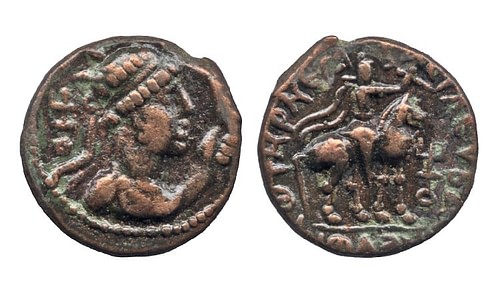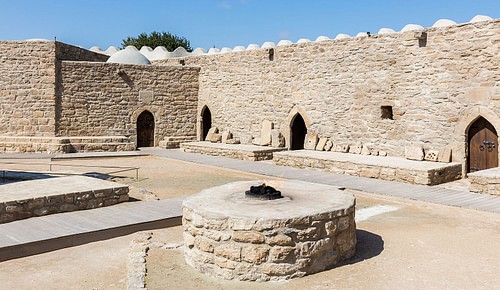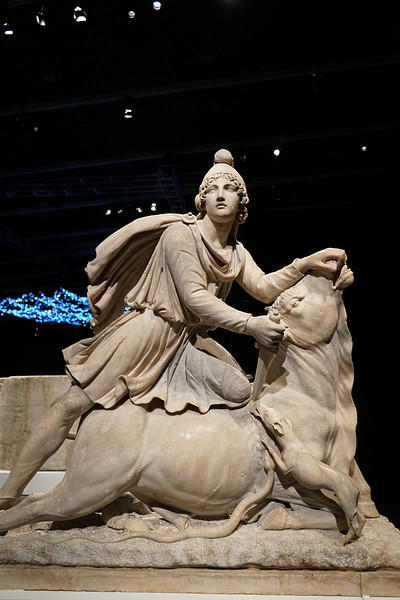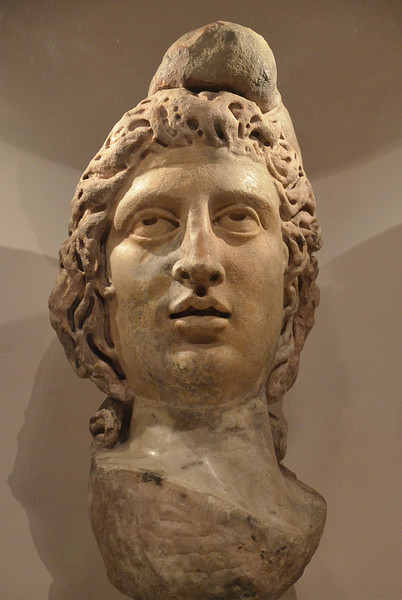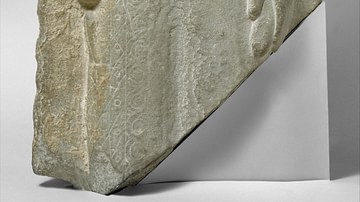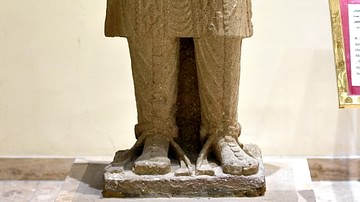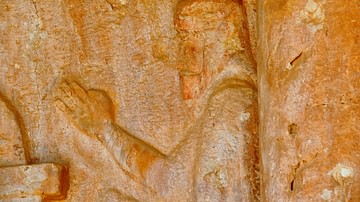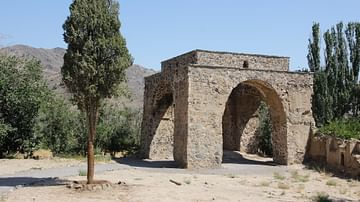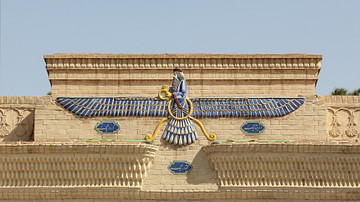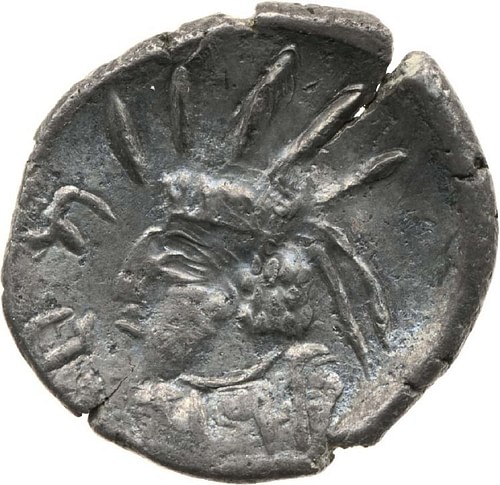
Mithra is the Persian god of the rising sun, contracts, covenants, and friendship. He also oversaw the orderly change of the seasons, maintained cosmic order, and was responsible for bestowing divine grace on kings, legitimizing their rule and, as a protector of the faithful, was also invoked by warriors before battle and so became known as a god of war.
He is the best-known and one of the most popular gods of the pantheon of the polytheistic Early Iranian Religion and his veneration continued after the monotheistic religion of Zoroastrianism replaced the earlier belief system.
He is linked to the Vedic god Mitra and is often associated with the Roman Mystery Cult of the god Mithras which flourished c. 100-400 CE throughout the Roman Empire, but these are two different deities, although Mithras is loosely derived from Mithra. Although the Roman Mithras and his cult have often been claimed as the precursor and model for Jesus Christ and Christianity, there is absolutely no historical evidence to support the assertion.
Mithra's name was invoked in inscriptions during the Achaemenid Empire (c. 550-330 BCE), notably during the reign of Artaxerxes II (404-358 BCE) and he was still acknowledged during the Sassanian Empire (224-651 CE). After the Sassanian Empire fell to the invading Muslim Arabs in 651 CE, Zoroastrianism – including worship of Mithra – was suppressed and, later, the Parsees carried the Zoroastrian texts and traditions to India where the faith was preserved intact. Mithra still plays an important role in modern-day Zoroastrian rites which continue the traditions of the ancient past.
Origin, Character, Depiction
Mithra originated at some point prior to the 3rd millennium BCE when migratory groups now known as Indo-Iranians and Indo-Aryans began settling in the regions of Iran and Northern India respectively. There are, therefore, a number of similarities between the Vedic deities and those of the Early Iranian Religion including the Persian Mithra and the Vedic Mitra.
The Vedic Mitra (sometimes given as Mitra-Varuna) was the god of contracts and the sunrise, fertility in the form of rain and good harvests, and keeper of truth. The Mitra-Varuna coupling joined the god of the sunrise with the powerful sky god Varuna and they were imagined as inhabiting a golden palace in the heavens with a thousand doors from which they would ride forth every morning in their brilliant chariot.
The Persian Mithra is described in the Avesta (Zoroastrian scripture) as:
He who first, of the heavenly gods, reaches over the Hara [Alburz Mountains], before the undying, swift-horsed sun; who, foremost in a golden array, takes hold of the beautiful summits, and from thence looks over the abode of the Aryans [Iranian peoples] with a beneficent eye. (Yasht 10.13, as cited in Curtis, 14)
He rides in a bright chariot drawn by white horses, bringing the rising sun, armed with a silver spear, a bow and arrows of gold, daggers, axes, and the mace which symbolizes his role as guardian of cosmic order and the god who legitimizes kingship. Mithra is ever vigilant and cannot be deceived, knowing the hearts and true intentions of people, and keeping the forces of darkness at bay. He was considered the most powerful force against the Lord of the Demons, Angra Mainyu (also known as Ahriman), who feared his mace more than any other of the gods' weapons.
Zoroastrianism – and presumably the Early Iranian Religion which it drew upon – focused on the conflict between the forces of good and order (led by Ahura Mazda) and those of evil and chaos (commanded by Angra Mainyu). The central purpose of human life was to choose which of these one would follow, and it was the responsibility of gods like Mithra to help people choose the right path and protect them from the lies and traps of the Evil One. Scholar John R. Hinnels describes Angra Mainyu's central character:
The Evil Spirit is said to have created 'non-life' (that is, a form of existence diametrically opposed to all that is good in 'real' life) and the Worst Existence. Appropriately, for a religion which has always taught appreciation of the good things in life, the destiny for the wicked is spoken of as 'a place of bad food'. It is 'the House of the Lie'. The forces of evil are said by Zoroaster to be the powers of Fury, Arrogance, and Bad Purpose. They destroy the World of Truth, harm cattle, and defraud man of the good life and of immortality. (52)
Against these forces, Mithra was a powerful defence. It was Mithra's responsibility to protect humanity - and, by extension, their crops and livestock – from the schemes of Angra Mainyu. To this end, one of his most important duties was legitimizing kingship in bestowing the farr (divine grace) on a worthy monarch who would care for his people and removing that grace when the king no longer lived up to his part of the contract.
He also served as judge of the souls of the dead at the Chinvat Bridge – the span between the world of the living and the afterlife – where his record of the soul's good and bad deeds was read and determined one's destination after death. Those who had followed Ahura Mazda went on to the House of Song; those who chose the path of Angra Mainyu were sent to the destination they had embraced all their lives, the House of Lies.
Zoroastrianism & the Achaemenid Empire
This depiction of the god and his role in maintaining order comes from the Zoroastrian texts but is thought to reflect his position and responsibilities in Early Iranian Religion. This belief system was an oral tradition – as was Zoroastrianism – and nothing was written down until the Sassanian Period. It is difficult, therefore, to know how Mithra was originally understood by the early Iranians, what parts of the Zoroastrian texts reflect the early understanding, and which parts were influenced by Zoroaster's reforms and the establishment of the new religion.
Zoroaster was a priest (magi) of this religion who, one day, received a vision that the people's spiritual understanding was wrong: there were not all these many gods, there was only one – Ahura Mazda – and it was now up to Zoroaster to correct his people's error. Zoroaster did so, founding the new faith of Mazdaism which became known as Zoroastrianism, and the old gods were reimagined as emanations (or avatars) of the one true god.
It has long been assumed that the first king of the Achaemenid Empire, Cyrus II (the Great, r. c. 550-530 BCE) was a Zoroastrian because the religion was firmly established in the region by the time of his reign. This is not necessarily so, however, because Cyrus the Great's inscriptions referencing Ahura Mazda could as easily be taken as referring to the king of the gods of the old religion as the one god of the new. This same holds true for Cyrus' successors, Darius I (the Great, r. 522-486 BCE) and Xerxes I (r. 486-465 BCE) who reference Ahura Mazda in the same way. Darius I even includes a reference to "the other gods" in his famous Behistun Inscription.
The association of the Achaemenid Empire with Zoroastrianism comes from Greek and later Roman writers and, while it is likely that the Achaemenids were Zoroastrians, it is not certain – at least not with the early monarchs. The inscriptions of Artaxerxes II list Ahura Mazda, Anahita, and Mithra, invoking their protection of his building projects, which has encouraged scholars in the past to conclude that Zoroastrianism was polytheistic. A more accurate interpretation, however, would be either that Artaxerxes II was not a Zoroastrian or that he was invoking Ahura Mazda as the one true god and Anahita and Mithra as protective emanations of the one deity.
Whichever it may have been, Mithra's status as protector of order and all-seeing god of justice continued as it always had. Neither the Early Iranian Religion nor Zoroastrianism believed in temples to their gods – believing the deities were too powerful to be confined to a house built by human hands – so it is not surprising that there are no temples to Mithra identified thus far (and, actually, more surprising that there have been so many clearly associated with Anahita). Mithra would have been worshipped like any of the other gods – at outdoor Fire Temples – where the elements of fire, air, earth, and water (personified by gods such as Atar, Mithra, Haoma, and Anahita) were honored. Worship of Mithra – or, at least, widespread veneration of the god as an avatar – must have continued because it was practiced by the Cilician pirates (a group comprised of many different nationalities) when they were resettled in Cilicia Campestris by Pompey the Great (l. 106-48 BCE) c. 66 BCE.
The Roman Cult of Mithras
It is probable that the Cilician pirates, who are said to have practiced some form of Mithra worship, inspired the movement which would become the popular Cult of Mithras in Rome. Roman soldiers serving with Pompey in Cilicia would have picked up the essentials of Mithra worship and popularized it in the legions. The problem with this theory, as with any other theory regarding the origin of the Cult of Mithras, is that no one knows how the cult began or where, how it spread, or even what it believed.
The claim that the Cilician pirates practiced Mithraism comes from Plutarch's Life of Pompey where he says the pirates at Cilicia "celebrated there certain secret rites among which those of Mithras continue to the present time, having been first instituted by them" (24.5). It would seem reasonable to conclude that the religious practices of the pirates were taken up by the legionaries of Rome and spread from there, especially since it is clear that the Cult of Mithras was most popular among the Roman army.
Since it is unclear, however, what the cult's tenets were – or what form the Cilician pirates' "secret rites" took – Cilicia cannot be positively identified as the point at which Persian Mithra was transformed into Roman Mithras. What is clear, though, is that there are significant differences between the two deities and how they were worshipped.
The Roman Mithras is a solar deity, keeper of contracts, order, and friendship – quite similar to the Persian Mithra – but the parallels end there. These characteristics, like anything else about the cult, come from physical evidence in the form of mosaics, statues, and reliefs, and from Christian writers critical of the religion. The adherents themselves wrote nothing down because they were initiates in a Mystery Cult – meaning a closed religious group who kept their beliefs and rituals secret – and were not interested in or allowed to share information with non-initiates.
Mithras is universally depicted in art as a young man slaying the celestial bull in an act interpreted as symbolizing death and rebirth. He is also depicted as being born of a rock, holding a torch as he emerges (emphasizing his role as a bringer of light), or shooting an arrow into a cloud (or rock) which is then seen to release water (identifying him with life, fertility). His worship was in secret, held in caves or subterranean temples built to resemble caves, and no women were allowed to join the cult. None of this iconography or ritual has anything to do with the Persian Mithra. Even so, as Hinnells points out, the people of the time associated Roman Mithras with the Persian god:
Mithraism was known to its contemporaries as "the Persian Mysteries" and Mithras himself was referred to as "the Persian god". Some explicitly attributed Mithraic teachings to Zoroaster. The Persian origins appear to be confirmed by some of the details in the Mysteries; there are, for example, recognizably Persian words used and one of the seven grades of initiation is that of the Persian. (78)
There seems no doubt that Roman Mithraism was inspired by the Persian Mithra, but this is not the same as saying there is any kind of continuation from Early Iranian Religion through Zoroastrianism to Roman Mithraism. Based on the archaeological evidence and early Christian criticisms of the cult, Mithraism was astrological in nature, focusing on divination, enlightenment in one's life, and rebirth after death. Initiates went through a number of trials which, once passed, elevated the adherent up a hierarchy of seven grades until they reached the highest – that of Father – who was regarded as an enlightened and protective priest figure. Initiates ate together, worshipped together, and observed Sunday as their sabbath which sparked one of the major criticisms of the cult by Christian writers claiming Mithraism was copying Christianity.
Mithras & Jesus
In an interesting twist, this claim would be reversed centuries later when French intellectuals popularized the claim that Christianity was a copy of Mithraism and that Christ had never existed. This claim has been repeated since in various forms, but the essential arguments are that Mithras is the model for the later creation of the character of Jesus Christ and that, like the "later Jesus", Mithras was born on 25 December of a virgin and visited by magi, had twelve disciples, celebrated a "Last Supper", and died on a cross. None of these claims has any merit whatsoever.
The so-called Christ Myth Theory was popularized, if not invented, by two French academics in the 18th century CE – Charles Francois Dupuis (l. 1742-1809) and Constantin Francois Chasseboef de Volney (l. 1757-1820). Dupuis was a Professor of Rhetoric at College de Lisieux, Paris and de Volney was a philosopher and orientalist. In the fervor of the French Revolution of 1789, many revolutionaries denounced Christianity – specifically Catholicism – as a myth which had encouraged the rise of the upper classes at the expense of the lower. Dupuis' 1794 13-volume Origine de Tous les Cultes (republished in English in 1872 as The Origin of All Religious Worship) popularized the claims listed above as well as many others but these were all fabrications of anti-Christian/pro-Revolutionary writers advancing their own agenda.
There is no evidence that Mithras – nor even Jesus for that matter – was born on 25 December. Mithras is depicted as emerging from a rock and never as an infant nor in any way associated with a virgin birth or a visitation by any magi. Mithras is never represented with any disciples at all, celebrated no "Last Supper", and did not die on a cross – in fact, there are no depictions of Mithras dying at all.
The fact that the claims of Dupuis and de Volney are outright lies, however, has not stopped them from being repeated by anti-Christian writers and pundits from the time of the 1872 publication to the present day. In recent years, these fabrications have been popularized by Zeitgeist: The Movie (2007) in Part I based on the book The Christ Conspiracy: The Greatest Story Ever Sold by Acharya S (pen name of Dorothy Milne Murdock, l. 1960-2015), and the irreverent documentary Religulous (2008) in which comedian Bill Maher repeats these claims as obvious and well-established truths.
Conclusion
The veneration of the Persian Mithra, as noted, continued into the Sassanian Period by which time the belief system of Zorvanism (often referred to as a heretical sect of Zoroastrianism) was established. Zorvanism held that the supreme god was Zorvan, Infinite Time, and Ahura Mazda and Angra Mainyu were both created beings. This being so, all the other gods were also created beings on almost equal footing with Ahura Mazda and so could be worshipped as deities in their own right.
The prophet Mani (l. 216-274 CE), founder of the religion of Manichaeism, stayed as a guest at the court of the Sassanian king Shapur I (r. 240-270 CE) and developed his concept of the Manichaean Mithra there (as he probably did with much of his religion). In Manichaeism, Mithra is interpreted as a savior-figure, bringer of light and order, and so retains two of his earliest known essential characteristics.
After the Sassanian Empire fell to the invading Muslim Arabs in 651 CE, the Parsees took the Zoroastrian texts which were not destroyed by the invaders and fled to India. They established their own community there which flourished and Mithra continues to be honored in their religious rituals in the present day. When a Zoroastrian priest is initiated, he receives the Mace of Mithra, symbolizing his responsibility to fight against the forces of evil and darkness.
The festival of Mithrakana (also known as Mithragan) is held yearly in Mithra's honor (at the autumn equinox), and the proper designation for a modern-day Zoroastrian temple is dar-I Mihr, "the gate of Mithra". Mithra remains a symbol of light and order in the present, just he was understood in the ancient past; making him one of the oldest gods in the world to be venerated, in essentially the same role, continuously for over 4,000 years.
